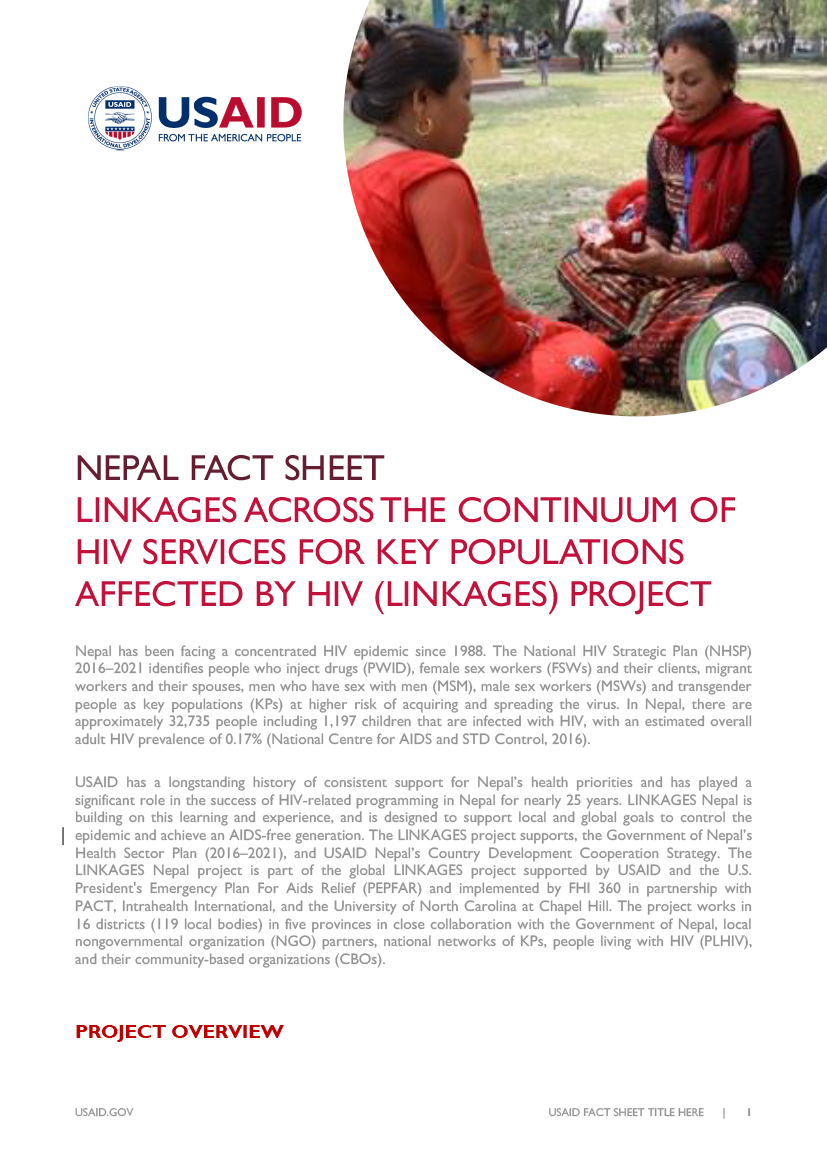Speeches Shim
Nepal has been facing a concentrated HIV epidemic since 1988. The National HIV Strategic Plan (NHSP) 2016–2021 identifies people who inject drugs (PWID), female sex workers (FSWs) and their clients, migrant workers and their spouses, men who have sex with men (MSM), male sex workers (MSWs) and transgender people as key populations (KPs) at higher risk of acquiring and spreading the virus. In Nepal, there are approximately 32,735 people including 1,197 children that are infected with HIV, with an estimated overall adult HIV prevalence of 0.17% (National Centre for AIDS and STD Control, 2016).
LINKAGES Project ![]() (pdf - 149k)
(pdf - 149k)
USAID has a longstanding history of consistent support for Nepal’s health priorities and has played a significant role in the success of HIV-related programming in Nepal for nearly 25 years. LINKAGES Nepal is building on this learning and experience, and is designed to support local and global goals to control the epidemic and achieve an AIDS-free generation. The LINKAGES project supports, the Government of Nepal’s Health Sector Plan (2016–2021), and USAID Nepal’s Country Development Cooperation Strategy. The LINKAGES Nepal project is part of the global LINKAGES project supported by USAID and the U.S. President's Emergency Plan For Aids Relief (PEPFAR) and implemented by FHI 360 in partnership with PACT, Intrahealth International, and the University of North Carolina at Chapel Hill. The project works in 16 districts (119 local bodies) in five provinces in close collaboration with the Government of Nepal, local nongovernmental organization (NGO) partners, national networks of KPs, people living with HIV (PLHIV), and their community-based organizations (CBOs).
PROJECT OVERVIEW
The goal of the project is to accelerate the ability of governments, KP organizations, and private-sector providers to collaboratively plan, deliver, and optimize services that reduce HIV transmission among KPs and extend life for those who are living with HIV. The project has three result areas:
Result 1: Increased availability of comprehensive prevention, care, and treatment services, including reliable coverage across the continuum of care for KPs.
Result 2: Demand for comprehensive prevention, care, and treatment services among KPs enhanced and sustained.
Result 3: Strengthened systems for planning, monitoring, evaluating, and ensuring the quality of programs for KPs.
PROGRAM ACTIVITIES
The project activities below will contribute to the goal and results areas of LINKAGES.
- HIV and Sexually Transmitted Infection (STI) prevention education, referral and follow-up through offline and online platforms (use of information and communications technologies), and condom promotion and distribution
- HIV testing and counseling (HTC) services including early infant diagnosis (EID) services
- STI examination and treatment services
- HIV Case management services and referral to and follow-up for anti-retro viral therapy (ART) and viral load test services
- Support and education for counseling for ART adherence and retention H
- HIV-related stigma and discrimination reduction
PLANNED RESULTS
Key Indicators and Targets (October 2016 to June 10, 2019) Indicators Target Number of KPs reached for HIV prevention 207,400 Number of KPs received HIV testing and counselling services 101,500 Number of HIV self-test kits distributed 3,000 Number of individuals enrolled on pre-exposure prophylaxis 180 Number of KPs examined for sexually transmitted infections 43, 000 Number of PLHIV enrolled in ART 800 Number of PLHIV receiving care and support services in the community 1,700 Number of condoms distributed 23 million Number of lubricants distributed 3.4 million


Comment
Make a general inquiry or suggest an improvement.